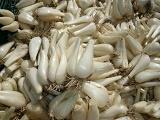Tottori Sakyu Rakkyou / Fukube Sakyu Rakkyou
| Registration Number | 11 |
|---|---|
| Name of the GI | Tottori Sakyu Rakkyō,Fukube Sakyu Rakkyō |
| Class | Vegetables/ Cereal grains/Pulses |
| Date of Protection | 2016/03/10 |
| Producing Area |
Tottori Prefecture
Fukube-cho, Tottori City, in Tottori Prefecture |
| Applicant - Name and Address | JA Tottori Inaba (Japan Agricultural Cooperatives) 1-103 Gyotoku, Tottori City, Tottori Prefecture, 680-0824, JAPAN |
Rakkyō is a bulb of member of the scallion family that looks like a smaller and slenderer onion. In Japan, it has been eaten sweet or salt pickled from olden times.
The Tottori Sakyu Rakkyō is a Japanese scallion cultivated in dune fields close to the Tottori Sand Dunes in Fukube, Tottori City in Tottori Prefecture, and it has a crunchy texture and whitish appearance.
When you look at a cross-sectional photograph, compared to ordinary scallions, the body is tight and the thickness of each layer is almost the same. Therefore, you feel the uniform firmness when you start chewing (outer layers) and finish chewing (inner layers), and it supposedly has something to do with its pleasant crunchiness. If its fracture strength is measured in comparison with ordinary scallions, data shows that the first scale is cut by a smaller load, and the second and subsequent scales continue to be cut by about the same load as the first scale.
The dune fields in this area are made up of mostly sandy soils with no excess moisture or nutrients. Therefore, as the scallion grows, the young leaf blades stop growing while the core matures, so the fibers become fine, the scallion firms up, and a crisp texture is obtained. The scallion grown in sandy soil does not have the original amber color but a whitish hue.
The history of scallion in the Fukube district reportedly goes back to the beginning of the Edo period, but it started to be grown in earnest around 1914. In the past, peaches and mulberry were planted to block blown sand, but the soil was not suitable and the fruit did not grow. After it was discovered that scallion could be grown even in poor soil, the topography was changed by leveling the hills to create the scallion fields. Since people acknowledge the scallion is resistant to drought, cropping has grown, and the area has now become one of the leading production centers in Japan. In late October, the light purple flowers of scallion all bloom together, and an expanse of purple carpet viewed from the distance has become a famous hallmark of the Tottori Sand Dunes.


